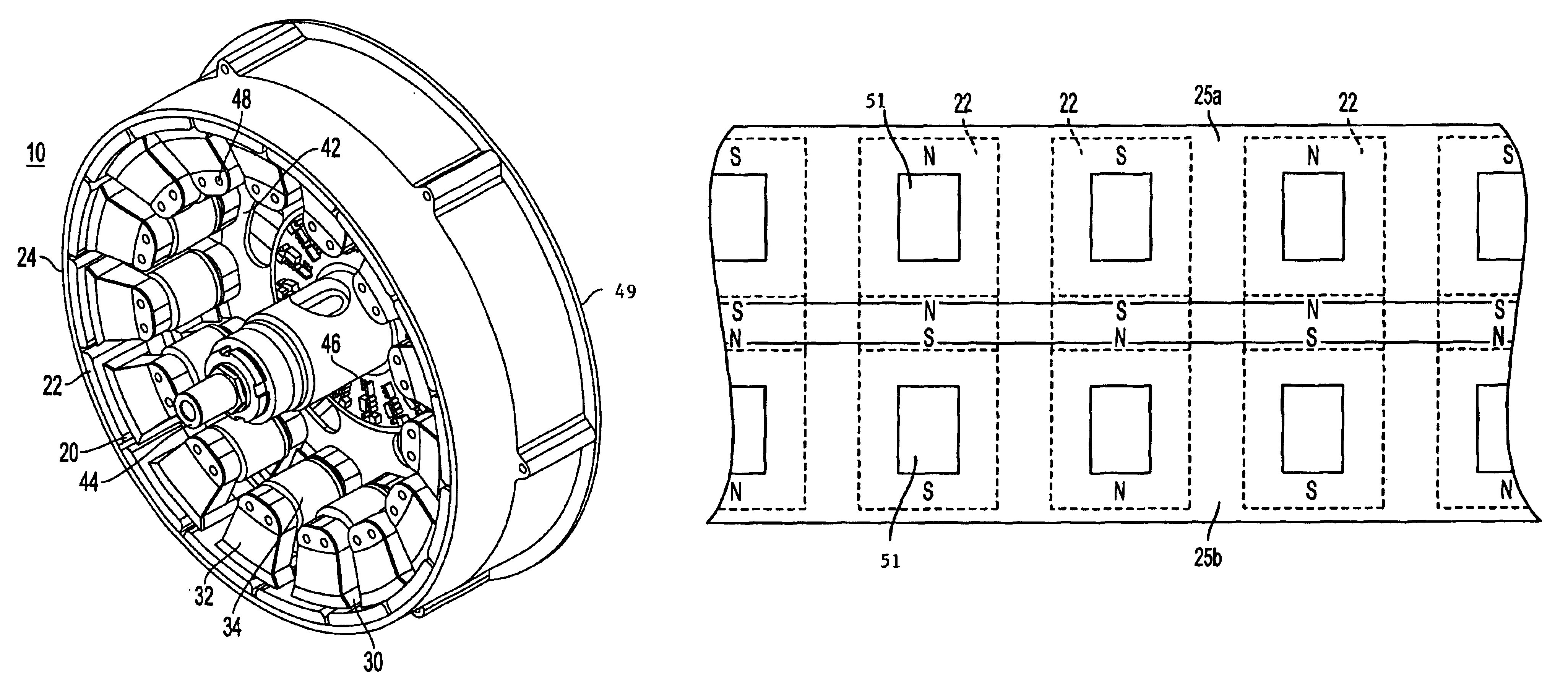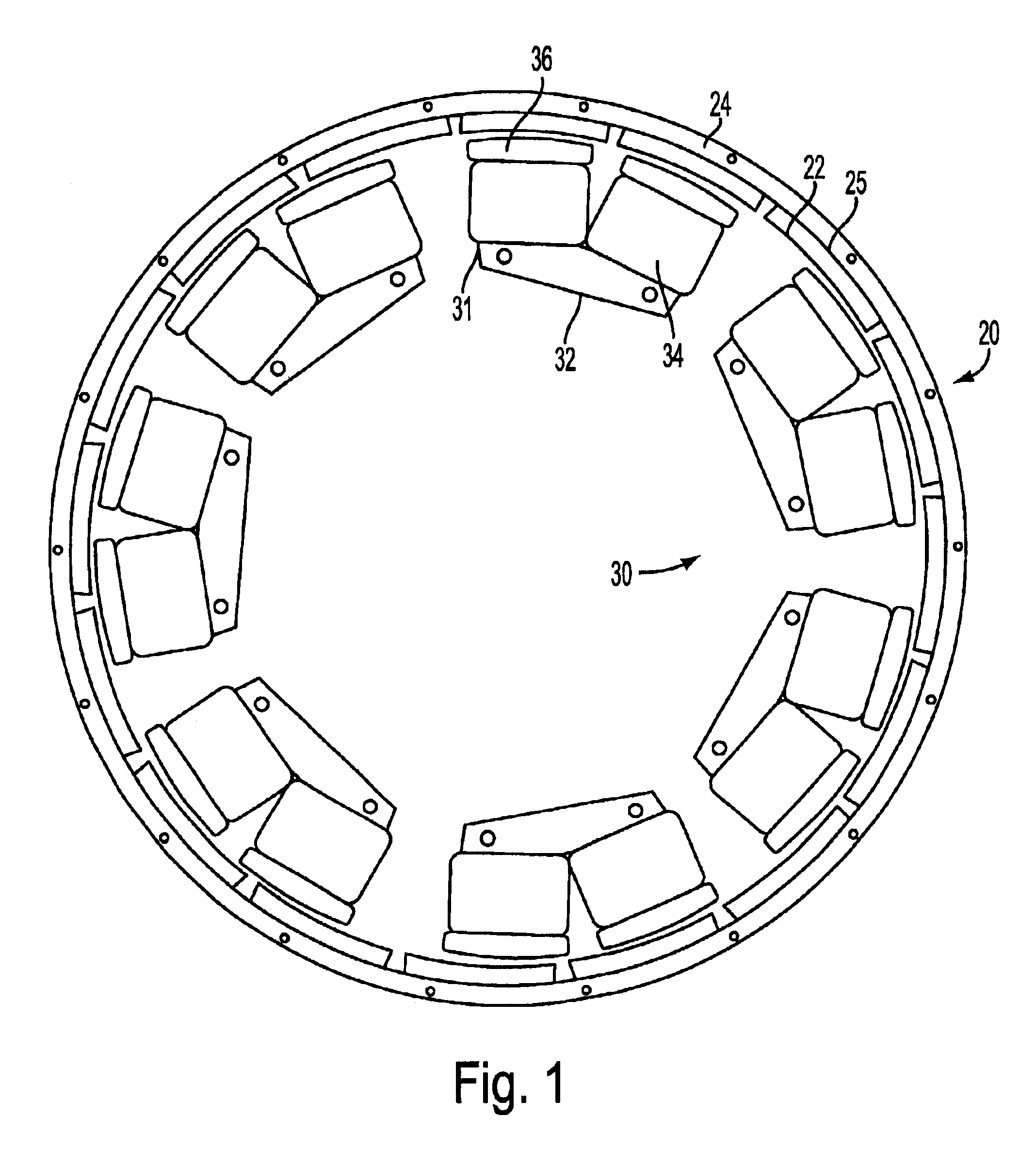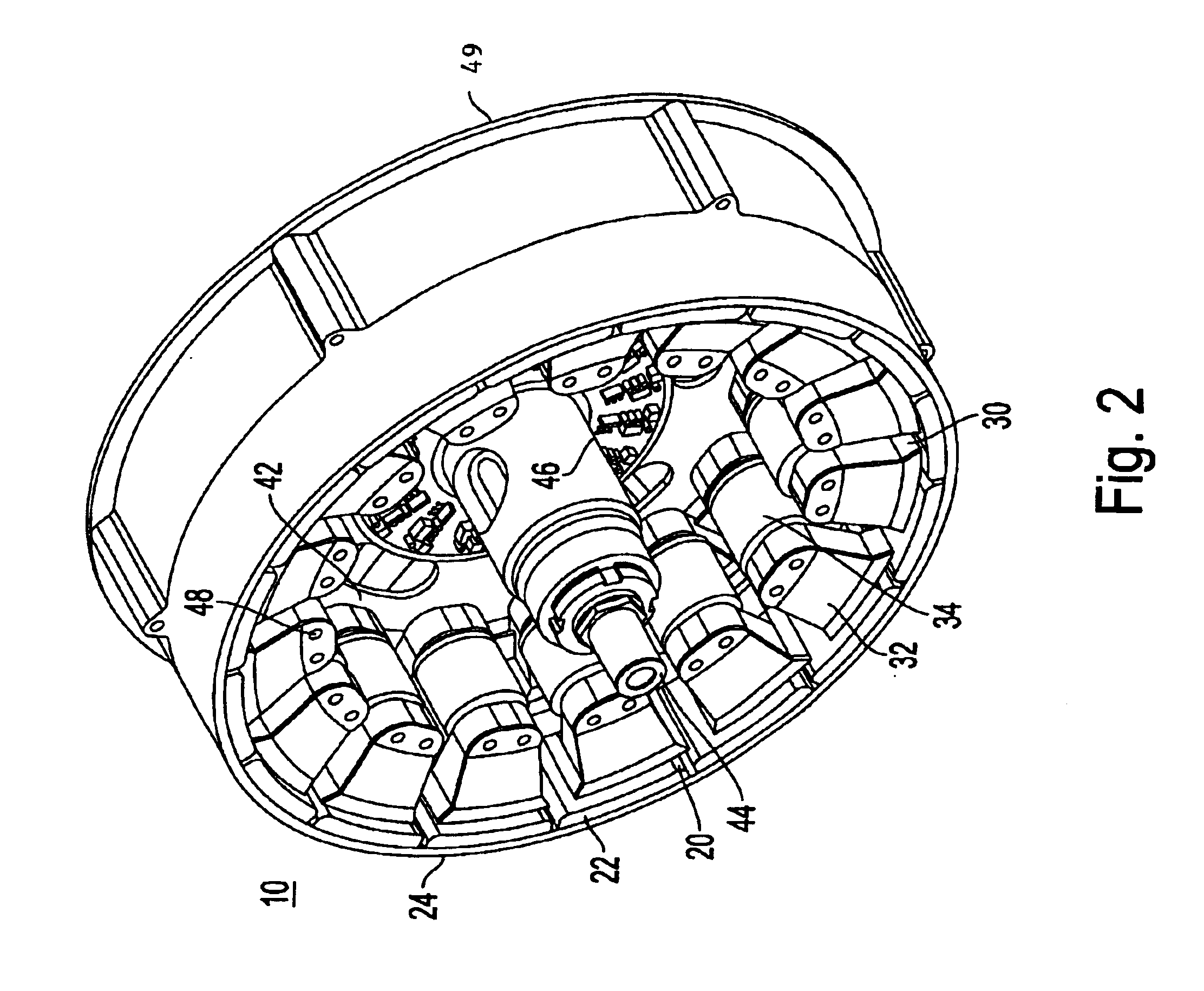The above-identified copending related U.S.
patent application of Maslov et al., number 09 / 826,423, identifies and addresses the need for an improved motor amenable to simplified manufacture and capable of efficient and flexible operating characteristics. In a vehicle drive environment, it is highly desirable to attain smooth operation over a wide speed range, while maintaining a
high torque output capability at minimum
power consumption. The copending related U.S. applications incorporate
electromagnet poles as isolated magnetically permeable structures configured in an annular ring, relatively thin in the radial direction, to provide advantageous effects. With this arrangement, flux can be concentrated, with virtually no loss or deleterious
transformer interference effects in the
electromagnet cores, as compared with prior art embodiments.
. With this arrangement, flux can be concentrated, with virtually no loss or deleterious
transformer interference effects in the
electromagnet cores, as compared with prior art embodiments.
The above-identified copending related U.S.
patent application of Maslov et al., number 09 / 826,423, describes optimization of rotor parameters such as the grade of the magnets, the
energy density and the overall magnetic characteristics of the
magnet grade, the size and the dimensions of the magnets. Adjustment of such parameters effect the working
permeance and the overall operating condition of the magnet when it is part of the rotor. Other factors are the temperature stability of the magnet, the finishing,
coating and post
processing steps taken in manufacturing of the magnets for the intended application, the stability of the
magnetization over the curvilinear surface of the magnet, uniformity of the
radial polarization of the magnet, the adjacent gap between two separate magnets, the mechanical features of the edges of the magnets, and the return flux path of the magnet as provided by a back iron ring section.
The Maslov et al. applications recognize that isolation of the electromagnet groups permits individual concentration of flux in the magnetic cores of the groups, with virtually no flux loss or deleterious
transformer interference effects with other electromagnet members. Operational advantages can be gained by configuring a single pole pair as an isolated electromagnet group. Magnetic path isolation of the individual pole pair from other pole groups eliminates a flux transformer effect on an adjacent group when the energization of the pole pair windings is switched. The lack of additional poles within the group avoids any such effects within a group.
FIG. 1 is a plan view of a motor such as disclosed in the above-identified 09 / 826,423 application. Reference is made to that application for a more detailed description. Rotor member 20 is an annular ring structure having a plurality of permanent magnets 22 substantially evenly distributed. The permanent magnets are divided into groups of north / south pole pairs, the permanent magnets of each group joined by magnetically permeable material 25 that serves as a magnetic return path between the adjacent permanent
magnetic poles 22. The permanent magnet groups each form a
magnetic circuit that is isolated from adjacent groups. Cylindrical back plate 24, of non-magnetically permeable material such as aluminum, joins the permanent magnet groups to form an annular ring. The permanent magnets alternate in
magnetic polarity along the inner periphery of the annular ring. The rotor surrounds a
stator member 30, the rotor and
stator members being separated by a radial air gap.
Stator 30 comprises groups of poles 31 of uniform construction that are evenly distributed along the air gap. Each stator group comprises a generally U-shaped
magnetic structure 32 having two pole faces 36 at the air gap. Each stator group structure is separate, and magnetically isolated, from adjacent groups. The legs of the poles are wound with windings 34. The windings, when energized, are configured to provide opposite north / south polarities to the poles of each pole pair, thereby forming an electromagnet. Reversal of polarity of energization effects reversal of the magnetic polarities of the pole pair. Appropriate timed switching of stator winding energization along the radial air gap effects
electromotive force generation through interaction of magnetic forces between the stator and rotor across the air gap.
Stator groups 31 are secured to non magnetically permeable support structure, not shown herein, whereby the stator groups form an annular ring configuration. A relatively narrow radial stator dimension provides a favorable concentration of flux within each stator element structure focussed at the air gap. By virtue of this configuration, and the absence of stray transformer effects from adjacent stator pole groups,
high torque output can be efficiently obtained.
The above-identified U.S. application Ser. No. 09 / 966,101 of Maslov et al. describes benefits to be gained from utilization of three dimensional aspects of motor structure. FIG. 2 is a cutaway view of a structure such as described in that application. Motor 10 comprises annular
permanent magnet rotor 20 and annular stator structure 30 separated by a radial air gap. The stator comprises a plurality of ferromagnetically isolated elements. Core segments 32, made of magnetically permeable material and isolated from direct contact with each other, have respective windings 34 formed thereon. The rotor comprises a plurality of permanent magnets 22, circumferentially distributed about the air gap and affixed to a non-magnetic annular back plate 24, which may be formed of aluminum or other non magnetically permeable material. The flux distributions produced by the
rotor magnets can be further enhanced by provision of a magnetically permeable element mounted to the back of the
rotor magnets. The stationary shaft 44, plates 42 and stator structure, are contained within a housing 49, to which the annular rotor backplate and permanent magnets are attached. Reference is made to the application for a more detailed description.
 Login to View More
Login to View More  Login to View More
Login to View More 


